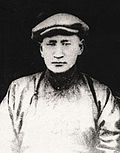| No. | Portrait | Name
(Birth–Death) | Term of office | Political party |
|---|
| Took office | Left office | Time in office |
|---|
|
| Prime Minister |
| 1 | | Tögs-Ochiryn Namnansüren
(1878–1919) | November 1912 | April 1919 † | 6 years, 5 months | Independent |
| 2 | | Gonchigjalzangiin Badamdorj
(1850–1921) | April 1919 | January 1921 | 1 year, 9 months | Independent |
| 3 | | Jalkhanz Khutagt Sodnomyn Damdinbazar
(1874–1923) | 22 February 1921 | May 1921 | 2 months | Independent |
| – | | Manzushir Khutagt Sambadondogiin Tserendorj
(1872–1937)
Acting | May 1921 | 10 July 1921 | 2 months | Independent |
| – | | Dambyn Chagdarjav
(1880–1922)
Acting
[b] | 13 March 1921 | 16 April 1921 | 34 days | MPP |
| 4 | | Dogsomyn Bodoo
(1885–1922) | 16 April 1921 | 7 January 1922 | 266 days | MPP |
| 5 | | Jalkhanz Khutagt Sodnomyn Damdinbazar
(1874–1923) | 3 March 1922 | 23 June 1923 | 1 year, 112 days | MPP |
| 6 | | Balingiin Tserendorj
(1868–1928) | 23 June 1923 | 28 November 1924 | 1 year, 158 days | MPP |
|
| Chairman of the Council of People's Commissars |
| (6) | | Balingiin Tserendorj
(1868–1928) | 28 November 1924 | 13 February 1928 † | 3 years, 77 days | MPP |
| 7 | | Anandyn Amar
(1886–1941) | 21 February 1928 | 27 April 1930 | 2 years, 65 days | MPP |
| 8 | | Tsengeltiin Jigjidjav
(1894–1933) | 27 April 1930 | 2 July 1932 | 2 years, 66 days | MPP |
| 9 | | Peljidiin Genden
(1892–1937) | 2 July 1932 | 2 March 1936 | 3 years, 244 days | MPP |
| 10 | | Anandyn Amar
(1886–1941) | 22 March 1936 | 7 March 1939 | 2 years, 350 days | MPP |
| Chairman of the Council of Ministers |
| 11 | | Khorloogiin Choibalsan
(1895–1952) | 24 March 1939 | 26 January 1952 † | 12 years, 308 days | MPP |
| 12 | | Yumjaagiin Tsedenbal
(1916–1991) | 26 January 1952 | 11 June 1974 | 22 years, 136 days | MPP |
| 13 | | Jambyn Batmönkh
(1926–1997) | 11 June 1974 | 12 December 1984 | 10 years, 184 days | MPP |
| 14 | | Dumaagiin Sodnom
(born 1933) | 12 December 1984 | 21 March 1990 | 5 years, 99 days | MPP |
| 15 | | Sharavyn Gungaadorj
(born 1935) | 21 March 1990 | 11 September 1990 | 174 days | MPP |
| Prime Minister |
| 16 | | Dashiin Byambasüren
(born 1942) | 11 September 1990 | 21 July 1992 | 1 year, 314 days | MPP |
|
| Prime Minister |
| 17 | | Puntsagiin Jasrai
(1933–2007) | 21 July 1992 | 19 July 1996 | 3 years, 364 days | MPP |
| 18 | | Mendsaikhany Enkhsaikhan
(born 1955) | 19 July 1996 | 23 April 1998 | 1 year, 278 days | Democratic |
| 19 | | Tsakhiagiin Elbegdorj
(born 1963) | 23 April 1998 | 9 December 1998 | 230 days | Democratic |
| 20 | | Janlavyn Narantsatsralt
(1957–2007) | 9 December 1998 | 22 July 1999 | 225 days | Democratic |
| – | | Nyam-Osoryn Tuyaa
(born 1958)
Acting | 22 July 1999 | 30 July 1999 | 8 days | Democratic |
| 21 | | Rinchinnyamyn Amarjargal
(born 1961) | 30 July 1999 | 26 July 2000 | 362 days | Democratic |
| 22 | | Nambaryn Enkhbayar
(born 1958) | 26 July 2000 | 20 August 2004 | 4 years, 25 days | MPP |
| 23 | | Tsakhiagiin Elbegdorj
(born 1963) | 20 August 2004 | 13 January 2006 | 1 year, 146 days | Democratic |
| 24 | | Miyeegombyn Enkhbold
(born 1964) | 25 January 2006 | 22 November 2007 | 1 year, 301 days | MPP |
| 25 | | Sanjiin Bayar
(born 1956) | 22 November 2007 | 29 October 2009 | 1 year, 341 days | MPP |
| 26 | | Sükhbaataryn Batbold
(born 1963) | 29 October 2009 | 10 August 2012 | 2 years, 286 days | MPP |
| 27 | | Norovyn Altankhuyag
(born 1958) | 10 August 2012 | 5 November 2014 | 2 years, 87 days | Democratic |
| – | | Dendeviin Terbishdagva
(born 1955)
Acting | 5 November 2014 | 21 November 2014 | 16 days | MPRP |
| 28 | | Chimediin Saikhanbileg
(born 1969) | 21 November 2014 | 7 July 2016 | 1 year, 229 days | Democratic |
| 29 | | Jargaltulgyn Erdenebat
(born 1973) | 7 July 2016 | 4 October 2017 | 1 year, 89 days | MPP |
| 30 | | Ukhnaagiin Khürelsükh
(born 1968) | 4 October 2017 | 27 January 2021 | 3 years, 115 days | MPP |
| 31 | | Luvsannamsrain Oyun-Erdene
(born 1980) | 27 January 2021 | 13 June 2025 | 4 years, 137 days | MPP |
| 32 | | Gombojavyn Zandanshatar
(born 1970) | 13 June 2025 | Incumbent | 132 days | MPP |





































